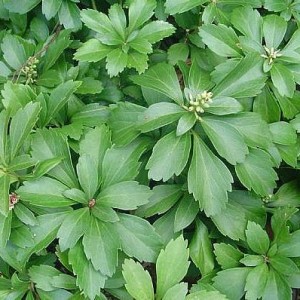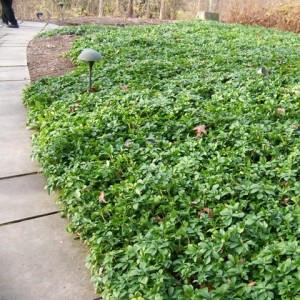Pachysandra is a beautiful groundcover plant. It not only looks great, it can reduce mulching needs on properties. If it is thick enough, pachysandra helps reduce weed growth as well. It seems pachysandra either looks great or it looks terrible. People often don’t understand some of the considerations for specific plants when it comes to insects and disease and care. If you have pachysandra in your landscape or are considering adding it, learn what it takes to grow and maintain. Otherwise, you’ll become extremely frustrated.
Exposure & Establishment
Pachysandra can adapt to light considerations, but it performs best when in shade or only partial sun. The best time to plant this groundcover would be early in the spring. You can plant it at other times, but you’ll have an increased need for watering, and may lose some plants. Likewise, if you install it in fall, you may lose some of the young, tender plants to winter injury. Be sure to prepare the soil where you are planting. Till it to loosen the soil so the pachysandra can root deeply and quickly. Add fertilizer and organic compost if possible, and cover the area with mulch to help retain moisture.

Know Pachysandra’s Enemies
Two of the top reasons pachysandra often dies or thins out are from insects and disease. The most common insect problem on pachysandra is Euonymus Scale. These insects often go unnoticed and untreated for years. Eventually, they are so bad that they cover the stems and undersides of leaves.
Scale Insects
This oblong, white, small scale insect essentially sucks the life out of pachysandra causing it to discolor and die off completely or in large areas. Once the population is heavy it is extremely hard to control. If you want pachysandra in your landscape beds, you’ll need to have a tree and shrub care program every year for your property. It’s just a matter of time before you will lose pachysandra without treating it regularly. Spray the pachysandra with horticultural oil according to label directions and also treat crawler (immature) stages of the insects when they hatch. Here in Central PA, best times to treat these are from late May through June for the first generation. A second generation of the insect will hatch from late July through early August, and we’ve even seen a third generation hatch if the fall stays very warm. Basically, you’re going to need to spray your pachysandra 3-5 times throughout the year depending on scale populations and weather conditions.
Volutella Blight
Another major consideration for pachysandra is the disease Volutella blight. This also causes wilting or dead areas in the bed. Individual plants will exhibit irregular tan to brown lesions on the leaves and eventually coalesce until the entire leaf dies. Inevitably, the disease will spread to stems and cause even more damage. Insect infestation, winter injury, excessive sun exposure and drought will increase the chance for this disease to grow. Moist, dark conditions will cause Volutella blight to spread, so make sure the stand of pachysandra is able to dry out. If there is excessive leaf litter under the plants, or the stand is even too thick, this will promote the disease to spread. Yes, you may need to thin out your thick pachysandra stand slightly. Fungicides can also be applied along with insecticidal sprays to reduce fungal growth during summer months when this disease begins to develop.

Fertilize, Water, and Thin
Fertilize your pachysandra beds annually with a balanced, granular fertilizer. Not only will this help promote good color, but it will help thinner areas to fill in. Plus, plants with nutrient deficiencies often are more susceptible to disease. Be sure to water your pachysandra during drought. Do this in the early morning. If possible, run soaker hoses through the beds and avoid overhead irrigation. Remember, warm, moist conditions will promote disease growth, so it is ideal to get the soil wet and not the leaf tissue. If the stand of pachysandra is too thick, stems and leaves will stay too wet. Thin out the stand by removing 20%-25% of growth evenly throughout so air can move in between plants to dry the stems and leaves. In some cases where there is heavy insect and disease populations, it may even be recommended to mow your pachysandra and let it re-grow to remove most of the fungal spores and insects.
Whether you are planting pachysandra or trying to maintain an existing bed of pachysandra, we would be happy to help. Our tree services include treatments for the pests listed above and our landscape team knows the correct way to plant pachysandra or thin pachysandra. If you would be interested in these services, please contact us.

